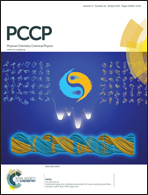Enhancement of the thermoelectric figure of merit in DNA-like systems induced by Fano and Dicke effects
Abstract
We report a theoretical study highlighting the thermoelectric properties of biological and synthetic DNA molecules. Based on an effective tight-binding model of duplex DNA and by using the nonequilibrium Green's function technique, the thermal conductance, electrical conductance, Seebeck coefficient and thermoelectric figure of merit in the system are numerically calculated by varying the asymmetries of energies and electronic hoppings in the backbone sites to simulate the environmental complications and fluctuations. We find that due to the multiple transport paths in the DNA molecule, the Fano antiresonance occurs, and enhances the Seebeck coefficient and the figure of merit. When the energy difference is produced in every opposite backbone site, the Dicke effect appears. This effect gives rise to a semiconducting–metallic transition, and enhances the thermoelectric efficiency of the DNA molecule remarkably. Moreover, as the Fano antiresonance point is close to the Dicke resonance one, a giant enhancement in the thermoelectric figure of merit in the DNA molecule has been found. These results provide a scenario to obtain effective routes to enhance the thermoelectric efficiency in the DNA molecules, and suggest perspectives for future experiments intending to control the thermoelectric transport in DNA-like nanodevices.


 Please wait while we load your content...
Please wait while we load your content...